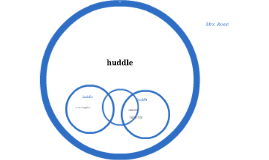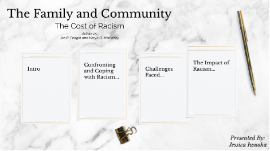Race & Ethnicity Powerpoint
Transcript: Presented By: Jessica Iwuoha Article 25 Joe R. Feagin and Karyn D. McKinney The Family and Community The Cost of Racism Intro Introduction "Racism takes a toll on people of color in multiple ways. The authors show how, even in the face of racist beliefs and actions that harm Black families and communities, those same institutions provide a defense against the harm that racism produces." Most African Americans see their families and communities as primary defenses against the daily assaults of racism. African American families and communities are negatively affected in many ways by continuing white-on-black racism. Family and communities have been closely linked... various white assaults on black families often have significant impact on the larger black communities. Example being... Found in the 1965 report, The Negro Family: The Case for Action, it writes that the center of the tangle of pathology is the weakness of family structure... In turn... White society is all but absolved of contemporary responsibility for poverty, deprivation, and family stress in black communites. Basically meaning... The labelling of urban black communities as a "tangle of pathology" is commonly shown in present day, shown as having weak kinship, "illegitimate" children, lack of values, and present-oriented rather than future-oriented. The Long-Term Ideological Assault on the Black Family Most social science researchers view African American families as distinctive in certain characteristics when compared to similar white families. What is disputed is whether these differences are seen as problematic. Rather than looking at African-American families as simply different in certain ways from white families, most literature portrays black families as problematic or pathological. Confronting and Coping with Racism... Strong and Adaptive Families Contrary to common belief and views of pathology advocates, African-American families, as well as black families, have long been characterized by strong kinship bonds and interactions. During slavery, one of the primary reasons enslaved A. Americans ran away was to return to their families. In fact, many who had escaped to freedom risked their lives to return South in attempt to free their families. Prime Example Although newly freed black parents struggled to feed their children, they often added to their families' innumberable "fictive kin" -- the extended family and non-kin children who were orphaned during or after slavery. Work Ethic Contrary to the "culture of poverty" thesis and commonplace white stereotyping, most members of black families exhibit a strong orientation towards work. Many studies showed that whites and blacks are similarly oriented in their attitudes towards work. Data showed that rather than working less hard than whites, most African-Americans realize that they often must work harder than whites just to achieve the same results. “You have to work twice as hard to get half as much.” Other Strengths... Adaptability in regards to Family Roles. Studies have found that A. American families are often more egalitarian than are white families. Strong Achievement Orientation. Education is highly valued in the black family/community as one way to help overcome poverty and racism. Strong Religious Orientation. This contributes to cohesive black families, and has been used as a mechanism of survival for black communities from slavery to present day. Challenges Faced... The Challenge of Difficult Economic Conditions Some of the most difficult problems faced by black families stem from outside economic forces. In which some of these have, unintentionally, a differential impact on African Americans, while other economic problems are created by government or private sector policies that unintentionally, or at least knowingly, have a negative impact on African-American families. Further explaining... The author, Joe R. Feagin, has distinguished between direct and indirect institutionalized discrimination. Direct I.D is that discrimination intentionally built into organization and institutions by whites in order to have a significant negative impact on people in subordinate racial groups, especially African-Americans. Examples include intentional exclusion, blatant or subtle, of A. Americans from traditionally white jobs and neighborhoods. Indirect I.D involves the differential and negative treatment by whites of subordinate racial groups without that treatment being intentional in the present moment. Example being that the past often creates limited resources for the descendants of those discriminated against, and current generations feel the effect of past discrimination. Continuing... In focus groups conducted by Fegin and McKinney, they found that many people explain in some detail how the stress of discrimination at work places has added burden on their relationships with their spouses. In which these cases, white racism has another negative, often energy-draining, effects on The

















